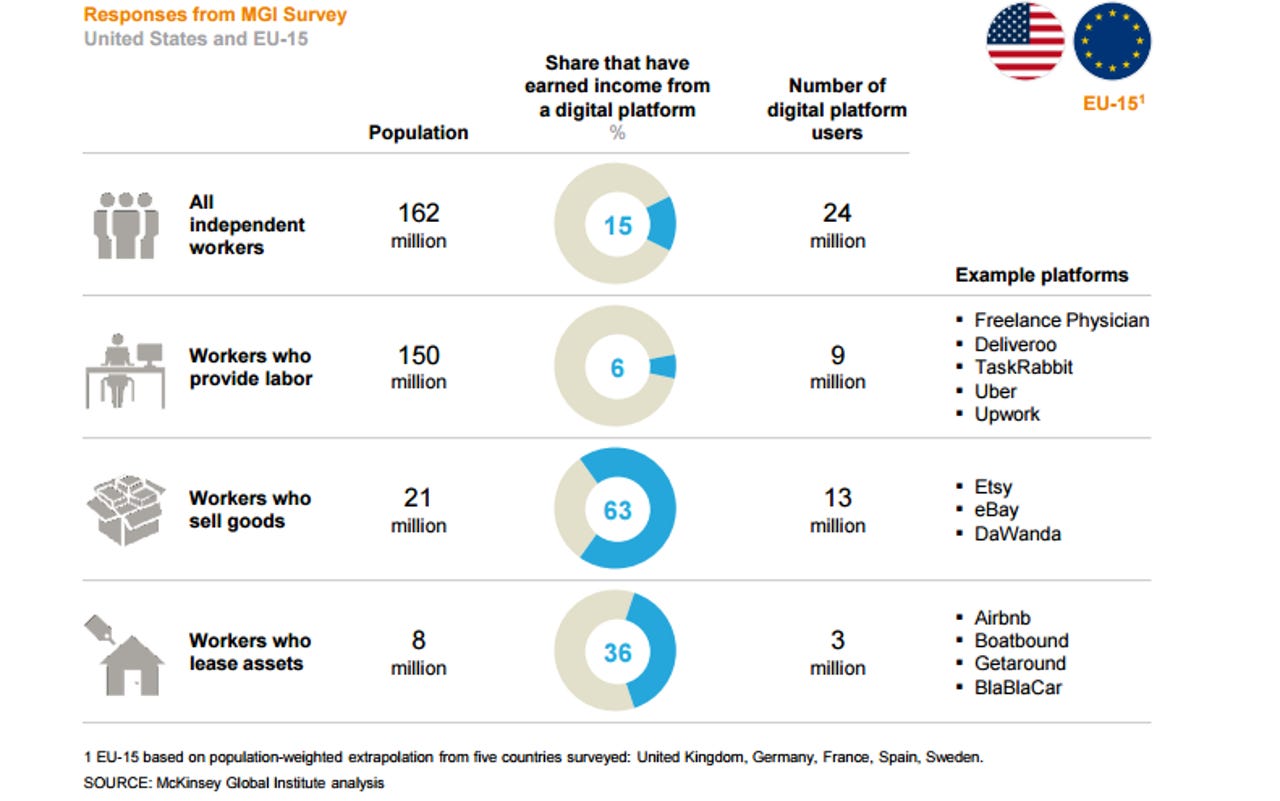Report: Portion of 'gig economy' workers on digital platforms is still small

The digital drivers of the so-called "gig economy" -- companies like AirBnB, Etsy, or Uber -- have garnered plenty of attention. Yet, so far, only a small fraction of independent workers in the US and Europe use digital platforms to earn income, according to a new report.
Up to 162 million people in the US and EU participate in the independent workforce, according to a new report from the McKinsey Global Institute -- somewhere between 20 to 30 percent of the working-age population. Yet just 15 percent of independent workers have used digital platforms to earn income -- that amounts to about 4 percent of the working-age population.
While digital platforms assist a small fraction of the workforce now, their potential to change the very nature of work is huge, McKinsey concludes:
Digital technologies have made it possible for new players to enter ecosystems of independent work and provide better matching mechanisms, in some cases creating new demand and making new types of independent earning activities possible. The real question underlying the growth of digital platforms for independent work is not how the numbers could grow. It is whether digital platforms could begin to challenge established notions of how companies are organized. Technology makes it conceivable that the old model of a corporation with employees in an elaborate hierarchy of specialized functions could one day give way to leaner core organizations that rely on a loose network of external providers for many activities.
McKinsey reached these conclusions by surveying about 8,000 respondents in the US and five European countries (the UK, Germany, Sweden, France, and Spain) about their income for the past 12 months. Government data gives a limited look at independent workers, since it primarily measures people engaged in the independent workforce as their primary source of income.
McKinsey's research suggests there are 54 million to 68 million independent earners in the US as well as 30 million to 62 million across those five European countries. It extrapolated the survey results to conclude there are a total of 162 million across the US and all of Europe.
"Independent work" is defined by three features, McKinsey explains: it has a high degree of autonomy; workers are paid per task, assignment, or sales; and there is a short-term relationship between the worker and client.
Using this definition, McKinsey found that more than half of independent workers are in this workforce to supplement their income, rather than as a primary means of support. About 70 percent of Etsy sellers and 60 percent of Uber drivers in the US have some other form of primary income, McKinsey said.
People who sell goods are the most likely to use digital services -- 63 percent of those workers in the US and the EU use digital platforms like eBay or Etsy. By comparison, 36 percent of those who earn independently by leasing assets use digital platforms such as HomeAway, Airbnb, or VRBO. Platforms for offering services, such as Uber, TaskRabbit, and Upwork, were used by only 6 percent of independent earners in the US and EU.

Yet by harnessing real-time information, the ubiquity of mobile devices, and the sheer number of workers and customers they can reach, these digital platforms are poised to grow rapidly.
"Decades ago, Ronald Coase noted that companies gather many functions within one organization because it was too cumbersome and costly to coordinate all transactions through an external marketplace," the report says. "But the internet is dramatically reducing those costs, making it possible to conduct more transactions beyond the boundaries of a firm. Digital platforms that create marketplaces for labor services further amplify that benefit."
Digital platforms, the report says could transform the independent workforce in a variety of ways: they could, of course, create a greater marketplace of independent workers. They can create faster and better matches of goods and services, seamlessly connecting two parties engaged in a transaction. They can also provide rich information signals and ancillary services like product ratings and reviews. Lastly, McKinsey noted, they can add more participants to the market with a marginal cost close to zero.